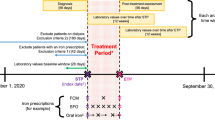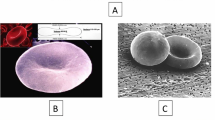Summary
We have investigated the effect of a purified preparation of Charybdotoxin (CTX) on the Ca-activated K+ (Ca−K) channel of human red cells (RBC). Cytosolic Ca2+ was increased either by ATP depletion or by the Ca ionophore A23187 and incubation in Na+ media containing CaCl2. The Ca−K efflux activated by metabolic depletion was partially (77%) inhibited from 15.8±2.4 mmol/liter cell · hr, to 3.7±1.0 mmol/liter cell · hr by 6nm CTX (n=3). The kinetic of Ca−K efflux was studied by increasing cell ionized Ca2+ using A23187 (60 μmol/liter cell), and buffering with EGTA or citrate; initial rates of net K+ efflux (90 mmol/liter cell K+) into Na+ medium containing glucose, ouabain, bumetanide at pH 7.4 were measured. Ca−K efflux increased in a sigmoidal fashion (n of Hill 1.8) when Ca2+ was raised, with aK m of 0.37 μm and saturating between 2 and 10 μm Ca2+. Ca−K efflux was partially blocked (71±7.8%, mean ±sd,n=17) by CTX with high affinity (IC500.8nm), a finding suggesting that is a high affinity ligand of Ca−K channels. CTX also blocked 72% of the Ca-activated K+ efflux into 75mm K+ medium, which counteracted membrane hyperpolarization, cell acidification and cell shrinkage produced by opening of the K+ channel in Na+ media. CTX did not block Valinomycin-activated K+ efflux into Na+ or K+ medium and therefore it does not inhibit K+ movement coupled to anion conductive permeability.
TheV max, but not theK m−Ca of Ca−K efflux showed large individual differences varying between 4.8 and 15.8 mmol/liter cell · min (FU). In red cells with Hb A,V max was 9.36±3.0 FU (mean ±sd,n=17). TheV max of the CTX-sensitive, Ca−K efflux was 6.27±2.5 FU (range 3.4 to 16.4 FU) in Hb A red cells and it was not significantly different in Hb S (6.75±3.2 FU,n=8). Since there is larger fraction of reticulocytes in Hb S red cells, this finding indicates that cell age might not be an important determinant of theV max of Ca−K+ efflux.
Estimation of the number of CTX-sensitive Ca-activated K+ channels per cell indicate that there are 1 to 3 channels/per cell either in Hb A or Hb S red cells. The CTX-insensitive K+ efflux (2.7±0.9 FU) may reflect the activity of a different channel, nonspecific changes in permeability or coupling to an anion conductive pathway.
Similar content being viewed by others
References
Abia, A., Lobaton, C.D., Moreno, A., Garcia-Sancho, J. 1986.Leiurus quinquestriatus venom inhibits different kinds of Ca-dependent K+ dependent K+ channels.Biochim. Biophys. Acta 856:403–407
Alvarez, J., Garcia-Sancho, J. 1987. An estimate of the number of Ca2+-dependent K+ channels in the human red cells.Biochim. Biophys. Acta 903:543–546
Bookchin, R.M., Ortiz, O.E., Lew, V.L. 1987. Activation of calcium-dependent potassium channels in deoxygenated sickled red cells.Prog. Clin. Biol. Res. 240:193–200
Canessa, M., Fabry, M.E., Blumenfeld, N., Nagel, R.L. 1987. Volume-stimulated, Cl−-dependent K+ efflux is highly expressed in young human red cells containing normal or Hb S.J. Membrane Biol. 97:97–105
Canessa, M., Spalvins, A., Nagel R.L. 1986. Volume-dependent and NEM-stimulated K+Cl− transport is elevated in oxygenated SS, SC and CC human red cells.FEBS Lett. 200:197–202
Castle, N.A., Strong, P.N. 1986. Identification of two toxins from scorpion (Leiurus quinquestriatus) venom which block distinct classes of calcium-activated potassium channel.FEBS Lett. 209:117–121
Cecchi, X., Alvarez, O., Wolff, D. 1986. Characterization of a calcium-activated K+ channel from rabbit intestinal smooth muscle incorporated into planar bilayers.J. Membrane Biol. 91:11–18
Cecchi, X., Wolff, D., Canessa, M. 1987. Charybdotoxin blocks the Ca-activated K+ channel in Hb A and Hb S human red cells.J. Gen. Physiol. 90:12a
Durham, A.C.H. 1983. A survey of readily available chelators for buffering calcium ion concentrations in physiological solutions.Cell Calcium 4:33–46
Escobales, N., Canessa, M. 1986. Ca2+-activated Na+ fluxes in human red cells: Amiloride sensitivity.J. Biol. Chem. 260:11914–11923
Fabry, M.E., Mears, J.G., Patel, P., Schaefer-Rego, K., Carmichael, L.D., Martinez, G., Nagel, R.L. 1984. An objective sign in painful crisis in sickle cell anemia: The concomitant reduction of high density red cells.Blood 64:1042–1046
Freedman, J.C., Hoffman, J.F. 1979. Ionic and osmotic equilibria of human red blood cells treated with nystatin.J. Gen. Physiol. 74:157–185
Funder, J., Tosteson, D.C., Wieth, J.O. 1978. Effects of bicarbonate on lithium transport in human red cells.J. Gen. Physiol. 71:721–746
Garcia, M.L., Gimenez-Gallego, G., Navia, M., Katz, G., Reiben, J.P., Kaczorowski, G.J. 1988. Purification and structural determination of charybdotoxin, a specific probe of Ca2+-activated K+ channels.Biophys. J. 53:151a
Gardos, G. 1968. The function of calcium in the potassium permeability of human erythrocytes.Biochim. Biophys. Acta 30:653–654
Grygorczyk, R., Schwarz, W. 1983. Properties of the Ca2+-activated K+ conductance of human red cells as revealed by the patch-clamp technique.Cell Calcium 4:499–510
Grygorczyk, R., Schwarz, W., Passow, H. 1984. Ca2+-activated K+ channels in human red cells. Comparison of singlechannel current with ion fluxes.Biophys. J. 45:693–698
Hladky, S.B., Rink, T.J. 1977.In: Membrane Transport in Red Cells. J.C. Ellory and V.L. Lew, editors. pp. 114–136. Academic, New York
Knauf, P.A., Furhmann, G.F., Rothstein, S., Rothstein, A., 1977. The relationship between anion exchange and net anion flow across the human red blood cell membrane.J. Gen. Physiol. 69:363–386
Lassen, U.V. 1977.In: Membrane Transport in Red Cells. J.C. Ellory and V.L. Lew editors. pp. 115–136. Academic, New York
Latorre, R., Miller, C. 1983. Conduction and selectivity in potassium channels.J. Membrane Biol. 71:11–30
Levy, S., Fein, A. 1985. Relationship between light sensitivity and intracellular free calcium concentration inLimulus ventral photoreceptors: A quantitative study using Ca-selective microelectrodes.J. Gen. Physiol. 85:805–841
Lew, V.L. 1971. On the ATP-dependence of the Ca2+-induced increase in K+ permeability observed in human red cells.Biochim. Biophys. Acta 233:827–830
Lew, V.L., Ferreira, H.G. 1976. Variable calcium sensitivity of a K+-selective channel in intact red cells membranes.Nature (London) 263:336–338
Lew, V.L., Muallen, S., Seymour, C.A. 1982. Properties of the Ca2+-activated K+ channel in one-step inside-out vesicles from human red cell membranes.Nature (London) 296:742–744
Miller, C., Moczydlowski, E., Latorre, R., Phillips, M. 1985. Charybdotoxin, a protein inhibitor of single Ca2+-activated K+ channels from mammalian skeletal muscle.Nature (London) 313:316–318
Moczydlowski, G., Latorre, R. 1983. Gating kinetics of Ca2+-activated K+ channels from muscle incorporated into planar bilayers.J. Gen. Physiol. 82:511–542
Reichstein, E., Rothstein, A. 1981. Effect of quinine on Ca++-induces K+ efflux from human red blood cells.J. Membrane Biol. 59:57–63
Romey, G., Lazdunski, M. 1984. The coexistence of two distinct classes of Ca2+-dependent K+ channels with different pharmacological properties and different physiological functions.Biochem. Biophys. Res. Commun. 118:669–674
Schefer, U., Amman, D., Pretsch, E., Simon, W. 1986. Neutral carrier based Ca2+-selective electrode with detection limit in the sub-nanomolar range.Anal. Chem. 58:2282–2285
Simons, T.J.B. 1976. Actions of a carbocyanine dye on calcium-dependent potassium transport in human red cell ghosts.J. Physiol. (London) 288:481–507
Smith, C.H., Phillips, M., Miller, C. 1986. Purification of Charybdotoxin, a specific inhibitor of the high conductance Ca2+-activated K+ channel.J. Biol. Chem. 261:14607–14613
Vestergaard-Bogind, B., Stampe, P., Christorphersen, P. 1987. Voltage-dependence of the Ca++-activated K+ conductance of human red cell membranes is strongly dependent on the extracellular K+ concentration.J. Membrane Biol. 95:121–130
Author information
Authors and Affiliations
Rights and permissions
About this article
Cite this article
Wolff, D., Cecchi, X., Spalvins, A. et al. Charybdotoxin blocks with high affinity the Ca-activated K+ channel of Hb A and Hb S red cells: Individual differences in the number of channels. J. Membrain Biol. 106, 243–252 (1988). https://doi.org/10.1007/BF01872162
Received:
Revised:
Issue Date:
DOI: https://doi.org/10.1007/BF01872162




